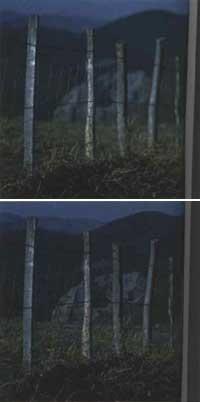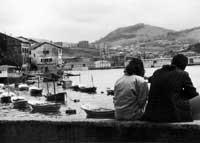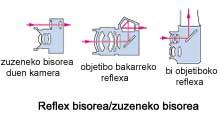Exposure (I): Exposure meters
1994/11/01 Nogeras, Itziar - Elhuyar Fundazioa Iturria: Elhuyar aldizkaria
In the previous section we said that to achieve adequate exposure it is necessary to know the sensitivity of the film and the clarity of the subject. We analyze the first. The second will be addressed right now.
The luminosity of the subject or matter must be measured in order to determine the diaphragm and the shutter speed, without forgetting that the measurement or reading must be in accordance with the sensitivity of the film.
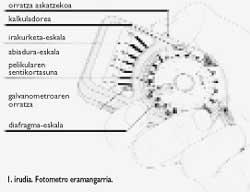
The most precise measuring devices are photometers or sposimeters. In addition, there are exhibition tables that manufacturers put in the instructions of the film.
These tables incorporate climatological symbols. Each symbol corresponds to a luminous situation (very sunny, luminous, quite cloudy, cloudy or with covered sky) and each of them, with a certain speed and sensitivity, indicates which diaphragm should be placed, since a change of speed would mean a proportional change of the diaphragm.
These instructions are usually for taking photos of conventional outdoor themes. More special situations (low light uniformity, indoor work with artificial light or sensitivity changes, e.g. ), do not provide the necessary information and the use of the photometer is essential.
The photometer has a light-sensitive surface (both the photoelectric cell and photoresistance) to be able to measure or read the light that reflects the subject. The photometer can be of two types: portable or with camera.
Portable photometer
The sensitivity of the film we are using in the corresponding box office is applied to the photometer. The sensitive surface is directed towards the subject and pressing on the detachment of the needle, the light intensity reflected is shown on the reading scale. The reading is placed on the calculator and rotates until the aperture ring reference matches it. This will show the combinations of diaphragms and speeds needed to achieve adequate exposure.
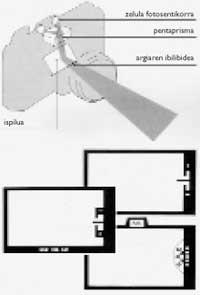
The sensitive surface of the photometer may be formed by a selenium cell that generates electricity through light (and therefore does not need batteries) and by a cadmium sulfide (CdS) photoresistance that is more sensitive (but needs batteries).
In the former, if there is strong light, a costume should be added to the photoelectric cell.
Built-in camera photometer
Most current cameras carry a photometer inside. The sensitive surface may be the one that carries inside and outside the camera. The sensitive surface can also be of the two types mentioned above: selenium or cadmium sulfide (also more modern silicon). The second is the most used.
When the sensitive surface is outside the camera, it does not measure the light that passes through the lens, but the light that goes directly from the subject. This, as we will see later, can cause errors that can be avoided when going inside the camera. SLR cameras usually use a CdS type meter and TTL system.
TTL stands for “through the lens”. It means that when the sensitive surface is inside the camera, it reads the light intensity that passes “through the lens”. In this way, the diaphragm and speed changes, both in the lens and in the filters, will have no problems, since the photometer will take everything into account.
These photometers are also attached to the speed and opening controls of the camera and are sometimes automatic. Reading information usually appears on the focus screen that can be seen through the viewfinder, both with needles and light indicators.
These meters can control exposure fully automatically, prioritizing opening, prioritizing speed or manually.
When the exposure control is fully automatic, the system itself determines the opening and speed, according to a preliminary program (often without showing any warning in the viewfinder). It is very comfortable for photos of bapat or beginners, but it does not allow to play, since the scheduled conditions cannot change.
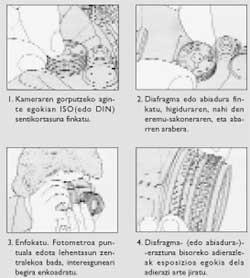
The following two options are semi-automatic and the information usually appears in the viewer. The first gives priority to openness. This means that the photographer chooses the diaphragm and the camera automatically selects the right speed. Control of depth of field of this system in important photographs (landscape, still life or approach, e.g. ex.) Suitable for use. When speed is prioritized, the photographer chooses speed and the camera automatically decides the right diaphragm. It is an appropriate system for moving photos.
These two preferences are usually optional for manually controlled cameras.
With manual control, according to the word itself, everything depends on the photographer. The aperture and speed will be the same, until the photometer indicates that the expulsion of light is adequate. It's the slower system, but the one that spends less and leaves the wider path to creativity.
It seems to you that in a few lines many technical and theoretical explanations have accumulated. Next time we will explain the reading of the exhibition in a much more practical way and do not hesitate that all these lines will relieve you. So bis.

Gai honi buruzko eduki gehiago
Elhuyarrek garatutako teknologia



